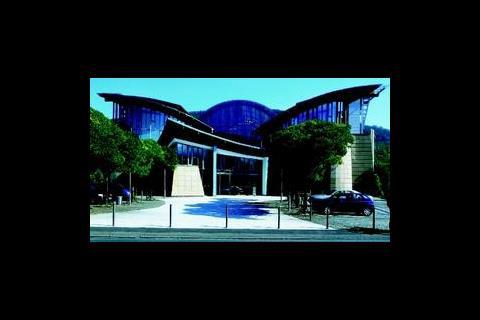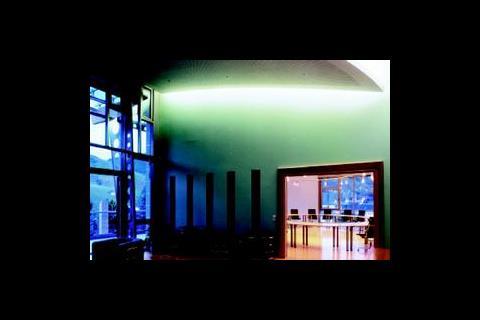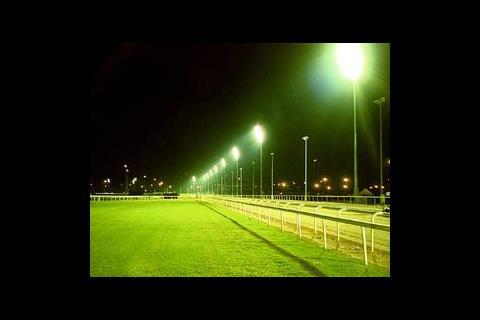In some types of project, the lighting design may be dictated by function, as in the upgrading of the Nad Al Sheeba racetrack in Dubai. Believed to be the world's largest floodlighting project, the brief was to bring the track up to international standards with illuminance levels sufficient for a worldwide television audience. The size of the project may have been exceptional but the general principles were exactly the same as they would have been at Aintree.
Achieving the desired result required increasing the lux levels from the existing 350 lux to 800 lux for the majority of the track, 1200 lux on the final 400 m finishing straight and 2000 lux at the finishing line. In all, Abacus Lighting supplied 1700 floodlights with 2 kW, 6000 K daylight lamps in wide beam and medium beam configurations – all driven by 3·6 MW of power from three new sub-stations. Commentating at the World Cup race former jockey, Willie Carson, commented: "it's like daylight down here".
However, there will always be projects where the function can be catered for while also addressing the local preferences and culture. One such example is the District Savings Bank in Bernkastel in the Moselle district of West Germany. This fairly boring, old-fashioned rectangular 1970s building was refurbished recently, transforming it to something that is a far cry from the traditional financial institution.
An important part of the local community, the bank now has a higher profile that stands out from the rest of the buildings in the small town, and lighting has played a major role in achieving this. In particular, the lighting has been used to help create a friendly and informal atmosphere with what are described as 'playful elements' – so much so that it is now used for public meetings and cultural events outside of banking hours. Which brings another perspective to the "my bank has been turned into a trendy wine bar" scenario.
Interestingly, there was nothing really new in the type of lighting used but the light has been applied in a way that we are unlikely to see in a UK bank. Or, at least, not one that is still a bank.
Other factors can also influence the design of a lighting scheme and provide a result that we would perhaps not consider in the UK. Here, most external floodlighting schemes are now using high-pressure sodium or metal halide light sources for the floodlighting to provide the desired colour rendering, colour appearance and energy performance. As such, these are an improvement on the energy-guzzling tungsten halogen floodlights that used to be the mainstay of many projects and designers have worked hard to shift that emphasis.
In certain parts of the USA, however, metal halide floodlighting is being replaced by fluorescent floodlighting. Waterleaf Communities in Florida has been using metal halide floodlighting for landscape lighting but in its most recent installation at Ruskin, Sun City Center, the landscaping department opted for 254 mm, 20 W fluorescent floods to replace 35 W metal halide for trees up to 3·7 m high and 457 mm fittings to replace 100 W metal halide floods illuminating trees from 6·0 m to 7·6 m.
According to the manufacturer of the fittings, this allowed them to double the number of fixtures connected to each circuit, reduce energy consumption by 60% and still retain appropriate lighting levels. An innovative and beneficial approach to landscape lighting, or good salesmanship? It's difficult to say.
Research
One of the things that really bugs UK lighting designers is the lack of lighting research carried out in the UK, compared to many other countries. For that reason, there are some important lessons to be learned from overseas research.
Like research the world over, the results of many hours of intensive study seem to state the obvious – though the value of having the obvious confirmed is undeniable. Researchers in North Carolina seemed to do just this in their study of the factors that would reduce work-related homicide.
However, the relatively high impact of lighting, compared to other measures such as cctv, may have surprised some people. "I think a lot of the interventions that we evaluated were considered to be intuitive things to do," says Dana Loomis, an epidemiologist at the University of North Carolina and lead author of the study. "Common sense approaches need to be scientifically evaluated before they're recommended."
Using the unfortunate phrase 'death on the job' to describe work related homicides, the Journal of the American Medical Association says that there are an average of 20 such killings a week in the USA. "Obvious measures such as installing video cameras to record crimes, storing cash in safes, and even having security guards doesn't appear to protect employees from deadly violence," said the researchers. However, eliminating solo night work was found to be effective, along with having well-lit work areas. In fact, having a well-lit storefront was found to cut the homicide rate by half.
It's important to stress, though, that lighting is just one of many factors in reducing crime, though its importance is supported by this latest research. "While individual measures may work for specific kinds of businesses, they're unlikely to apply across the board," says Jess Kraus, director of the Southern California Injury Prevention Research Center at the University of California at Los Angeles School of Public Health. However, he believes a combination of interventions that focus on factors like lighting and visibility, as well as employee training, may have broad success at reducing worker killings.
On a more cheerful note, researchers in France have been investigating why the take-up of lighting controls has been slow compared to most other countries and came up with some useful pointers for anyone specifying control systems, as well as lighting design in general. S Escuyer and M Fontoynont of Laboratoire des Sciences de l'Habitat carried out a study of 41 office occupants in three different buildings, each of which had a different lighting control system. These were dimmable lighting with manual, semi-manual, and automatic control.
As noted earlier, some studies confirm what we think we already know and the results of this survey confirmed three common assertions about lighting:
- Most people considered that having a reasonable amount of daylight penetrating the office was very important for well-being in offices.
- The preferences of people as regards the illuminance level varied greatly (100-600 lux).
- The people for which the essential activity was working on the computer tended to choose low illuminances (100-300 lux).
In addition, a number of more original or controversial results were identified:
- People tended to choose a lower level of artificial light when more daylight entered the office.
- Many people added less than 280 lux of artificial light on the desktop, even in workplaces where daylight illuminances were mostly low (0-100 lux).
- Automatic dimming in the buildings studied was not annoying for the respondents but manual dimming was more likely to produce conscious satisfaction.
- People took few initiatives concerning the use of the remote control, which probably made the control systems less beneficial than they could be.
- Having special lighting scenarios for different activities seemed to be a concept more appropriate for meeting and conference rooms than for offices.
As computer technology causes the world to shrink before our very eyes, the lessons we can learn from overseas colleagues become even more accessible and, therefore, more useful. In the case of lighting and its interaction with the eye, a biological structure we all share regardless of our geographical location, the lessons that can be learned from lighting professionals anywhere have an important role to play in the design of our own lighting systems in the UK.
Source
Building Sustainable Design
Postscript
Paul Haddlesey is editor of Lightseek.com























No comments yet